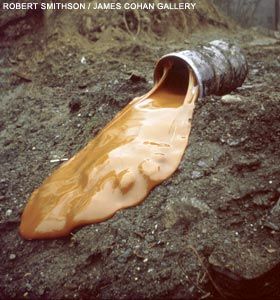Land-art
Sobre land-art, hoje no The Guardian
To understand land art - how it is reaching its apotheosis at the same time as it nears its end - we have to trace its origins. This isn't easy: like many artistic movements, land art has several genealogies. None the less, most critics are content to point to an exhibition, held in late 1968 at the Dwan gallery in New York, as the true starting point for the movement. The exhibition was called Earthworks; the name, tellingly, came from a dystopian novel about ecological catastrophe. Featured in the gallery spaces were several artists working in a vaguely organic way - exhibiting mounds of pungent soil, photographs of scarred wheat fields, etc. All the artworks seemed to be saying something about our strained, filial relationship with Mother Earth.
Sobre um dos mais importantes artistas deste movimento: Robert Smithson

Robert Smithson, GLUE POUR, Vancouver, Canada
December, 1969
A ler com atenção e tempo: Le territoire dans l'art des annès 60
Sobre land-art, hoje no The Guardian
To understand land art - how it is reaching its apotheosis at the same time as it nears its end - we have to trace its origins. This isn't easy: like many artistic movements, land art has several genealogies. None the less, most critics are content to point to an exhibition, held in late 1968 at the Dwan gallery in New York, as the true starting point for the movement. The exhibition was called Earthworks; the name, tellingly, came from a dystopian novel about ecological catastrophe. Featured in the gallery spaces were several artists working in a vaguely organic way - exhibiting mounds of pungent soil, photographs of scarred wheat fields, etc. All the artworks seemed to be saying something about our strained, filial relationship with Mother Earth.
Sobre um dos mais importantes artistas deste movimento: Robert Smithson

Robert Smithson, GLUE POUR, Vancouver, Canada
December, 1969
A ler com atenção e tempo: Le territoire dans l'art des annès 60






Sem comentários:
Enviar um comentário